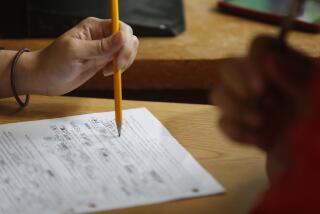Forgetting You Have a Poor Memory
- Share via
This is part of a continuing series of free-lance columns that help explain how to deal with everyday situations in our lives and/or how to make life more enjoyable. You’re in a panic. You have a 10 o’clock appointment with what’s-his-name. Or is it 11 o’clock? You’d call to pin down these essentials, except you’ve forgotten the phone number as well.
Sound familiar? Each of us has cursed our memory at one time or another. Arthur Bornstein, a teacher of memory techniques in Los Angeles since 1953, says: “Most people have a good memory, but have not learned to use it effectively or efficiently.”
During his career, those taught by Bornstein include a UCLA student who remembered 2,000 dates from the back of H. G. Wells’ “Outline of History.”
Memory systems are based on association techniques using the imagination, logic and concentration. For example, Bornstein tells students that they can remember the telephone number of his school (478-2056) by imagining four 78-year-olds learning memory techniques from a 20-year-old teacher who makes the students feel as if they are 56.
Bornstein also uses a numerical alphabet for the recall of numbers. Each consonant has a number value; vowels have no value. The letter equivalents are made into words, each of which can be easily associated and remembered. For the following example, you need to know that one equals T or D, two equals N, five equals L and eight equals F or V.
This system will be used to learn two dates: the year Napoleon Bonaparte was defeated at Waterloo (1815) and the year he died (1821). Imagine Napoleon being beaten over the head by a fiddle while a huge wall of water crashes around him. Now see him faint. He is dead.
Seeing Napoleon being beaten with a FiDdLe gives you the numbers 815, or 1815. The fist number “1” doesn’t matter, because most people know the millennium in which Napoleon lived. Nor does the double-D, since together they make only one sound. The association with water is a reminder that this defeat was at Waterloo. Seeing Napoleon FaiNT gives you the numbes 821, or 1821. Your mental picture should clue you that this is the year he died.
Association techniques can be used to link names to faces. Some names can be easily visualized, like Archer, Wolf or Barber. Others are abstract and require a little more work. For example, to remember the name of the governor, George Deukmejian, Bornstein sees royalty--a duke--dressed as a drum major. A duke is doing this because the attitude is to “let George do it.” For Barbara Walters, he visualizes Walter Winchell playing with a Barbie doll. Memory techniques can also be used to teach vocabulary or foreign words. Slake, noisome and bellicose are three words that may be encountered by college-bound students on the Scholastic Aptitude Test. Slake means to quench or satisfy. Noisome means foul-smelling. Bellicose means warlike.
Mental Pictures
To remember the first word, imagine yourself walking to the bank of an s-shaped lake for a cool drink of water. For the second word, imagine someone holding up a skunk, asking “Does this annoy some?” For the third word, see bells lining the coast, each of them surrounded by gun-toting soldiers.
See for yourself whether these techniques work. What is the telephone number of the Bornstein Memory School? What year was Napoleon defeated at Waterloo? When did he die? Define slake, noisome and bellicose.


